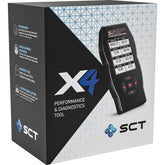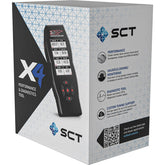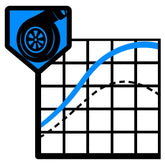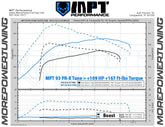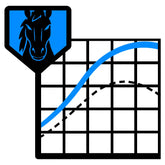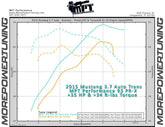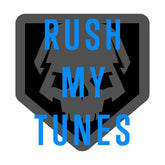LET'S GO RACING - TRACK TIPS
Let’s face it… We all love racing. There are few things more gratifying than putting your hard work, time, and hard earned money to the test and running a great time out at the track. But if you’re not an experienced racer, or a track veteran, it can be a little intimidating when you first line up in those staging lights. So, we thought we would take a little time and give you a few tips on how to make the most of your track visits.
Short list: 60' is everything, data log your runs at the track.
There are a few things you should prep ahead of time, before even heading out to the track. Check out the list below for more info.
- Check all fluids and make sure they are all topped off and in good condition. - You’ll be asking for maximum performance from your vehicle, so you want to make sure it’s up to the task and protected from the abuse you’ll be putting it through. Also, you want to make sure you have good quality fuel in your tank. We like to run around a ¼ tank when we go to the track. This keeps excess weight down, but also ensures we don’t uncover the fuel pump pick up when accelerating hard off the line. You also want to run the highest octane fuel that you have readily available. We’re shooting for maximum performance here, so do yourself a favor and DON'T RUN 87 OCTANE. If your vehicle is FlexFuel enabled, you should top off with some E85 for even better performance. An E30 mixture is a great solution for vehicles that are not flexfuel.
- Check the condition and pressure of your tires. - This should come as common sense, but if you’re going to be heating your tires with a burnout and traveling at a high rate of speed shortly after, you should make sure your tires are in good shape. Look for things like nails or other foreign objects in the tire, bumps or deformations in the tire, separation of the belt, or excessive wear. Also, check the pressure in all tires. You may decrease rear tire pressure while at the track, to improve traction, but you should start with the recommended tire pressure for your vehicle (usually around the 35 psi range), especially if you are driving to the track on the same tires you will be racing on. This is also a good time to check the torque on all of your lug nuts. You definitely don’t want to find out your lug nuts are not properly torqued when clearing the traps at 100+ MPH. This is also a good time to check for and remove any caked on dirt or mud. Not only is this extra weight, but mud or dirt that drops off the vehicle can cause a loss of traction when trying to accelerate, and that’s a one-way ticket to slow-ville.
- Wear long pants and closed toe shoes. – Most tracks will require you to wear pants and closed toe shoes, but even if your track doesn’t, it’s a good idea. In the event something catastrophic happens, long pants may provide enough added protection to prevent serious injury. Closed toe shoes that fit well are also par for the course. Your feet are just as important as your hands when racing, and possibly even more important, since your right foot will be controlling the “loud pedal”. So, shoes that fit well, laces that don’t dangle, and shoes that allow you to easily use any of the pedals without interfering with the others should be considered mandatory.
- Check your safety equipment. – This recommendation will apply differently, depending on how fast you are, and the requirements of your local track. Make sure all of your safety equipment is in good condition, up to date, and meets current rule standards. Regardless of your E/T a good quality helmet is a great idea, and having a fire extinguisher on-board is an inexpensive investment that you’ll be glad you have, should you ever need it.
- Get your datalogging equipment set up! – Datalogging at the track is CRUCIAL! Even the best dyno’s are not able to fully duplicate the conditions that are seen during a ¼ mile pass. So, if you’re serious about lowering your E/T’s, you need to collect data. If you’re running an MPT tune, you can follow the instructions we’ve listed in the Tech Support section of our site, record a log, and email it to Tunes@MorePowerTuning.com for review. If there is any room for improvement that we notice when reviewing your logs, we will make those changes for you, free of charge in most cases. There is no replacement for quality logs. So, if it’s your first time logging, record a couple practice logs before heading to the track. Email those practice logs over to us, and we’ll let you know if you’re good to go for the track.
*For best datalog reviews, include a copy of your time slip that matches the datalog(s) that you’re submitting. If submitting multiple logs and time slips, please label each one accordingly.
At the track!
If you’ve followed all the tips above, you should be pretty well set-up for hitting the track. Now that you’re at the track, let’s talk about how we work on chopping down those E/T’s.
Burnouts
Burnouts are probably one of the most debated things in drag racing. Each person has their own “style” or “method”, but not all of these methods are correct. The point of a burnout is to heat the tire, which softens the tire compound, and can improve traction. However, there are a few key points to consider when deciding how long your burnout should be, or even if you need to do a burnout at all.
In general a shorter burnout is better. This will minimize excess tire wear and also prevent overheating the tire compound which can cause the tire to become “greasy” and not bite as hard. Another rule of thumb is that the hotter the track temp, the less burnout is needed. So, as track temps decrease, your burnout length should increase. The idea is to optimize tire temp to match the track surface and temp.
Tire type will also play a very big role in your burnout. See below for info regarding the most common tire types:
- Street Tires – Street tires do not require a burnout and should not be heated. The compound on most street tires is designed to work at much lower temperatures than a race tire. So, doing a burnout on a street tire will overheat the compound and cause it to have less traction. For street tires, you should lower tire pressure by 5-10 psi from the recommended base setting. Then, drive around the water box completely. Lastly you can give the tires a light scuff to knock off any surface dirt, just before staging.
- Drag Radials – Drag radial tires can give you the best of both worlds when heading to the track. It’s a tire that you can drive to and from the track, and that can also hook up extremely well and provide consistent handling at the top of the track. Key points for most drag radial tires include running a lower tire pressure than you would use in a street tire. Usually 20 psi is a good starting pressure for most drag radial tires. For the burnout, you should typically avoid the water box still, however a lower powered vehicle may have trouble spinning a sticky tire like a drag radial. In this case, you can go around the water box, then back into it, pull out, and complete the burnout. Most drag radials do not require a lengthy burnout, and a good rule of thumb is to spin the tire until you see smoke, and then release the brake and drive out of the burnout.
- Slicks – Slicks are designed for one purpose only, maximum traction. Slick tires are offered in different compounds and a harder compound will require a longer burnout to reach operating temperature. Most slicks will require much less pressure than street tires, and a good starting point is usually around 15 psi. Slick tires will be much harder to spin, so you will need to wet the tires in the water box. Pull through the water box slowly, so that you do not throw water into the wheel wells, were it could later drip off onto the tire. Once through the water box, perform your burnout. You’ll want to heat the tires until you see a fair amount of smoke, and then release the brake and drive through the burnout.
Differentials, Transmissions, 4WD, and Traction Control
One of the most common questions that we see when guys are heading to the track is what they should do regarding their drivetrain. So, let’s touch on that a bit.
- Differentials – Diffs come in a few flavors, but the most common are open, limited slip, and lockers. Each diff will require a different strategy when at the track.
- Open Diffs (one wheel peel) are the least desirable option at the track, because if one tire spins all of your engine power is transferred to the tire that is spinning, which is definitely not ideal for acceleration. Since open diffs do not spin both tires, it’s best not to perform a burnout before staging. Doing so will cause one tire to be hotter than the other tire which could cause uneven traction when launching. If you have an open diff, you will only need a light scuff of the tires before staging. An open diff also poses a challenge when launching and will generally require a less aggressive launch to prevent wheel spin. You need to avoid wheel spin at all costs with an open diff, since all of your power is transferred to the slipping wheel with an open diff.
- Limited Slip Diffs (LSD) are the preferred choice for dual purpose street/strip use. The design of a limited slip diff allows for equal power to be put to both tires, but in the event that one wheel spins, torque is then transferred to the wheel with traction. This is a much more efficient method for getting down the track quickly. LSD’s do not suffer from the same problems as open diffs, so burnout guidelines above will apply, depending on your tire type. A LSD will also allow for a more aggressive launch, since power is being applied equally to both tires. Because of this, it is generally easier to cut a more consistent 60’ time, which ultimately leads to lower ET’s.
- Lockers or E-Lockers – Locking diffs are a great option for the track, but are a little less forgiving on the street. A locker does exactly as the name implies, it locks both axles together so that they spin in unison. So, it’s nearly impossible to lose traction on a single tire. Having both axles locked is the ultimate for traction out of the hole, and can allow for a very aggressive launch. However, any loss of traction can be very sudden and violent because the axles are locked together. That being said, locking diffs can require some skill to drive safely, so practicing a few launches before hitting the track is not a bad idea. Also, if your vehicle is equipped with an electronic locking diff (E-Locker), you should unlock the diff before trying to turn the vehicle, especially at high speeds.
- Transmissions – This is a pretty simple topic, but still a very common question.
- Manual Trans – Manual guys…. It’s all about seat time. Practice…. Practice…. And practice some more. Consistency in your shifts and your launches are what will lower your times here. Focus on the launch, lowering your 60’ as much as possible, and nailing the 1-2 shift. If you can get past those first couple of seconds of your run, the rest is just driving.
- Auto Trans – If you’re running an MPT tune, then you should always allow the transmission to shift automatically. We have already optimized shifting in our Performance Race and Street tunes for best performance on and off the track. That being said, shifts are based off of MPH, and things like different sized tires and different gears will cause MPH to be off, which will cause shifts to be off. So, if you have a set of tires that you use for the track, that are a different size than what you run on the street, be sure your tune is properly set-up for those tires. Also, if you feel like shifting could be optimized a bit more for your particular set-up or track conditions, simply record a log or two for us to review.
- 4WD - Should I launch in 4HI?? This question comes up pretty often, and there’s no definite answer. Launching in 4HI will definitely lower your 60’ times, especially for vehicles that produce a lot of low end torque. But it can be incredibly hard on your driveline as well. Also, turning four wheels requires more power than turning two wheels. So, running in 4wd will typically lower trap speeds, and once you’re past the 60’ mark will generally run slower. Fastest passes will always be achieved in 2wd, so focusing your efforts on cutting a consistent launch and 60’ in 2wd will generally pay off in the end.
- Traction Control – If you want to be fast, you’ve got to turn off traction control. This is a pretty simple process for most vehicles, but newer 2011+ Ford vehicles require a couple steps to disable the traction control and AdvanceTrac systems. To disable these systems in a 2011+ Ford follow these steps:
- Press and hold the brake pedal.
- While holding the brake press the Traction Control Disable button. You should see a message displayed reading “Traction Control Disabled” or something similar.
- Continue holding the brake and press and hold the Traction Control Disable button for approximately 10 seconds. You should see a message displayed saying “AdvanceTrac Disabled” or something similar.
Following these steps should disable the systems in all but the most extreme losses of traction. However, some high powered vehicles may still have instances when the Traction Control system intervenes and kills power when it is not needed. In these cases some racers prefer to remove the ABS fuse, which will COMPLETELY disable any AdvanceTrac and Traction Control functions. Pulling the ABS fuse will also disable the Anti-Lock function of the brake system in most cases, and will also disable the function of the Electronic Locking differential on vehicles equipped with that option. Pulling the ABS fuse should only be used as a last resort and only by experienced racers.
The Launch - a slow 60' will kill your time!
“Getting out of the hole” is by far the most important factor to running a consistent ET at the track, but it is also one of the most overlooked. Drag racers know that races are often won and lost in the first 60’. Focusing your efforts on lowering your 60’ time will pay big dividends in lowering your ET. A good rule of thumb is every tenth of a second (0.1 sec) that you can shave off your 60’, will also lower your ET by around two tenths of a second (0.2 sec). That means shaving just 0.2 second off of your 60’ time could make you nearly a half second faster in the ¼. That could be the difference between an 11 second ride and a 10 second ride. That’s why whenever you see someone mention or post their ¼ mile time, you’ll always see experienced racers chime in with “What was your 60?” Experienced racers know that without knowing the 60’ time of a pass, it’s impossible to know where there might be room for improvement. So, here’s a few tips to help chop down that 60’.
- Unbolt the end links or remove the front sway bar. - This will help with weight transfer to the rear wheels on the launch, but please note that if you drive to the track with the sway bar removed or unbolted, you should take corners a bit more cautiously.
- Buy a quality tire pressure gauge, and use it. - Lowering and raising tire pressures are key to maintaining traction with changing track conditions, and a quality tire pressure gauge is key to consistent pressures. As a general rule of thumb you should lower tire pressure if the tire spins and increase pressure if the engine bogs out of the hole.
- Eliminate wheel hop. – Not only does wheel hop slow you down, it can quickly destroy rear axles and differentials. Leaf spring equipped vehicles tend to be most prone to this problem, but any vehicle can suffer from wheel hop. Traction bars, upper and lower control arms, and panhard bars are all good options for helping to eliminate wheel hop. In the event that you experience wheel hop at the track, the best course of action is to release the accelerator, and slowly feed the power back in. Trying to “drive through” wheel hop is a sure fire way to break some expensive drivetrain parts.
- Ignore the yellow lights. – If you’re simply looking to lower your ET, like on a test and tune night at your local track, then reaction time is irrelevant and it will not affect your ET in any way. Take your time when leaving the line. If the other guy leaves before you, let him. Focus on YOUR launch and being consistent. Develop a system and repeat the same steps every time. Once this becomes second nature, and you’re cutting consistent 60’ times, you can start working on dialing in your RT (reaction time).
- Buy good tires. – If you’re serious about racing, then quality tires should be on your short list. Without traction you’ll have a hard time cutting quick 60’ times. Just like you wouldn’t go off-roading with drag radials, you shouldn't expect your 35” all-terrain tires to perform well at the track.
- PRACTICE!! – The single most important factor to cutting a low 60’ and ET is consistency, and that only comes with practice. Seat time is the only way to figure out how to get your vehicle out of the hole quickly. Maybe you need to flash the converter before leaving. Maybe you need to leave off idle. Maybe you need to roll into the throttle instead of pinning it. These are questions that you can only answer by testing them for yourself. Again, in general if you’re spinning, leave less aggressively. If you’re bogging, leave harder. The key is knowing what works for YOU, and practice is how you get there.
- Have fun! – Last but certainly not least. Have fun, and be safe.

